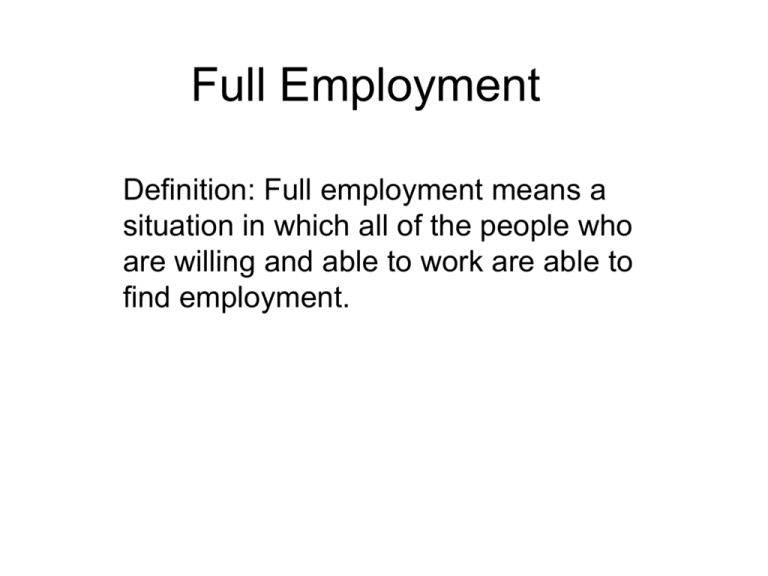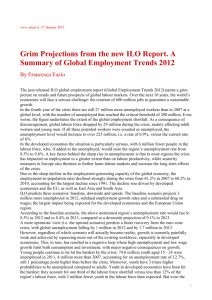Full Employment
advertisement

Full Employment Definition: Full employment means a situation in which all of the people who are willing and able to work are able to find employment. Measurement and Goal: • The data is collected every month. The ABS collects the information by performing a random survey of 0.7% of all Australian households. • The data that they show is the percentage of people who are in the labour force and unable to find employment. Performance Despite our improvement, Australia has a higher unemployment rate than most of our South East Asian neighbours. Most OECD countries, as shown in ‘International Comparison’ have higher unemployment rates than Australia. Recent Performance Australia’s unemployment rate fell steadily between mid 2001 and the end of 2005. Strong domestic economic growth, low interest rates and high levels of government expenditure have been the main reasons for the decline. International Comparison Singapore – 3.4% South Korea – 3.7% New Zealand – 3.7% Taiwan – 4.1% Japan – 4.2% United Kingdom – 4.6% United States – 5.0% Australia – 5.1% Hong Kong – 5.7% Canada – 6.6% EU Average – 7.7% International Comparison cntd. International comparisons still show Australia’s unemployment conditions as “middle of the road”. The debate in 2006 is on how the recent declines in our unemployment levels can be sustained and further reduced to levels below 5%. Recent major industrial relations reforms have been suggested by some commentators as being likely to assist in this process. Limitations of Official Statistics 1. Many unemployment benefit recipients have been shifted into disability pensions or the “youth allowance”. This removes people from the official unemployment statistics. 2. Some People simply lie deliberately mislead the survey takers Further Measurement limitations • Others are employed but seek extra work. These people are known as the disguised unemployed. • There are those that come under the heading of the hidden unemployed. These people do not have a job, but they have given up actively seeking employment. They have lost confidence in themselves. Underemployed A tighter work test and a weakened means test for unemployment benefit recipients has encouraged people to seek a few hours work here and there while staying on benefits. Because the ABS does not count as unemployed people doing one hour paid work per week or more, these people are not aprt of official unemployment statistics. However they are clearly unemployed. Real Unemployment Rate It has been estimated that if these figured are included, the “real” unemployment rate would be around 10%, compared to the current rate of 5.1% Another Limitation 2. Discouraged workers who withdraw from the job market are not registering as unemployed workers. Maintaining Low Unemployment • Governments need to meet those Economic Objectives Low Inflation 1. Maintenance of a low inflation enviroment which will generate “sustainable economic growth” is an important ingredient in limiting growth in unemployment levels. Low Inflation – Federal Govt. The Federal government also aims to prevent major economic imbalances, such as rising inflation. • In early 2005 this potential imbalance led to a tightening of monetary policy, truncating excessive economics growth and limiting the process of furthur reduction in unemployment. • In early 2006 accelerating inflation due to rising oil prices, strong wage demands and a waning of the positive effects on inflation from our recent $A appreciation may require further RBA intervention to prevent the imbalances of an inflation outbreak reemerging. Labour Market Reform Labour market reform involves individual contracts and enterprise bargaining, lower entry level training and wages, reduced trade union influence and targeted training which promotes a better synergy between labour market supply and demand. Excessive Wage Growth Excessive wage increases and structural impediments in the labour market will lead to higher unemployment. Labour market deregulation can promote greater competition and flexibility and prevent the excessive wage growth. Improved Productivity Reduction in the real unit cost of labour will also provide an incentive for increased employment of a well-trained labour force. The likelihood of excessive wages growth is reduced. Improve Training Improved training and on the job skills for the long-term unemployed, “work-for-thedole” scheme, are designed to increase job skills for the long-term unemployed and allow them to respond to higher labour demand. Job Networks • Job Network has introduced 300 community and private sector employment placement agencies into competition to find suitable work for the unemployed. Tax and Welfare Reform The taxation package introduced in July 2000 aimed in part to reduce business costs by the scrapping of the wholesale sales tax. Removal of distortions in the taxation system will lead to more efficient resource allocation and an improvin business climate, and job creation. Welfare Reform The combination of a loss of welfare benefits and marginal income tax rates on income earned acts as a disincentive to unemployed persons wishing to re-enter the labour force. 2003/2004 Budget In the 2003/04 budget, increasied family tax benefits and higher income tax thresholds were announced. In the 2004/05 and 2005/06 budgets, a further round of measures to reduced welfare traps and improve incentives to work were introduced. Welfare to Work The “Welfare to Work” reforms include lower marginal tax rates for low income earners, requiring recipients of the parenting Payment to seek work when children reach a certain age, and provision of assistance to employers wishing to engage long-term unemployed.






